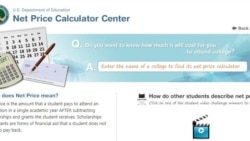Understanding the cost of attending a college or university in the United States is not always easy.
All colleges and universities in the U.S. are able to set their own tuition and housing prices, as well as charge other program fees.
A student may be able to find these costs listed on a school’s website or in a college advice book. But such estimates usually do not include other costs related to higher education, such as books and supplies, transportation and cost of living.
That is why the U.S. Congress passed the Higher Education Opportunity Act, which created new rules for how schools present this information, in 2008.
Part of this law requires all colleges and universities that accept students’ federal financial aid to report on the total cost of their programs. The Department of Education collects data from the schools on average tuition payments as well as averages of other hidden costs. The agency also collects data on scholarships and other forms of aid the schools give to students to help reduce those costs.
Another requirement is that the schools must have a tool on their websites that provides specific estimates of all costs for students. This tool is meant to gather information about an individual’s financial situation and calculate how much aid the school might offer them. The tool then presents the student with a price estimate that takes that aid into consideration. The final result is known as the net price.
However, a new study suggests that many schools are not fully meeting the law’s requirements for these net price calculators. And experts worry this could harm students’ abilities to make the best decisions when applying to colleges and universities.
Researchers with the University of Pennsylvania’s Graduate School of Education looked at the net price calculators of 80 schools. Half of them were public colleges and universities. The other half were private non-profit institutions. They were all schools with a high percentage of students who receive Pell grants, a form of federal financial aid that goes to poorer students.
The researchers released their findings last month. They found many of the school’s net price calculators to be lacking in some way. Nearly a third of the school’s calculators did not meet the federal government’s definition of net price, failing to include costs like books and supplies.
Additionally, half of the schools’ calculators were using data that was at least two years old. The links to the calculators for five of the schools did not work every time the researchers used them. And, two of the schools had no calculator at all.
Laura Perna is a professor at the Graduate School of Education and the lead researcher on the study. She notes that while the group of schools is rather small, the findings do suggest a larger problem.
In fact, a 2012 Institute for College Access and Success study of net price calculators at 50 colleges and universities had similar results.
Perna’s study did not look at why schools might be failing to meet the government’s requirements. But she did say there is no governing body at the Department of Education that punishes schools for not providing up-to-date, correct net price calculators. And there is no single design for the calculators that schools are required to use.
As the cost of college continues to rise, a school presenting older, less costly net price data might appeal to more students. And a higher application rate makes the school appear more desirable overall, Perna says.
“Some of the practices hopefully are not being done simply because institutions … want … more applications, but there could be some motivations along those lines as well,” she told VOA.
But, Archie Cubarrubia argues that the reasons behind this are likely more related to operational problems that schools face. He is vice president for policy and advocacy for Partners for College Affordability and Public Trust. In 2008, he was working for the Department of Education and helped create the guidelines for net price calculators.
He notes that presenting net price data that is complete and up to date is very important.
It is especially important for poorer students, who might only apply to colleges if they seem within their budget.
But Cubarubbia adds that the 2008 law require colleges and universities to report huge amounts of all kinds of data. Not all of it is related to cost, and most of it comes from several different departments within the schools.
Institutions with larger budgets are able to make sure that the necessary data is communicated effectively between departments and with the government, he says. Those schools are better able to make sure the calculators on their websites are providing up-to-date information. But, that is not always the case at schools with competing budgetary concerns.
“What ends up happening is because the federal requirements are so piecemeal and different offices … are responsible for different pieces, … one piece falls through the cracks and nobody’s … looking at it,” said Cubarrubia. He adds that the government should consider simplifying its data requirements.
Last month, U.S. lawmakers proposed the Net Price Calculator Improvement Act to Congress. It is aimed at creating a stronger definition of the data that go into net price calculations and how schools must present such tools.
I’m Pete Musto.
And I’m Dorothy Gundy.
Pete Musto reported this story for VOA Learning English. Ashley Thompson was the editor. We want to hear from you.
How difficult is it for students to understand the cost of higher education in your country? Write to us in the Comments Section or on our Facebook page.
________________________________________________________________-
_________________________________________________________________
Words in This Story
tuition – n. money that is paid to a school for the right to study there
scholarship(s) – n. an amount of money that is given by a school or an organization to a student to help pay for the student's education
specific – adj. relating to a given person or situation
calculate – v. to find a number or answer by using mathematical processes
apply(ing) – v. to ask formally for something, such as a job, admission to a school or a loan, usually in writing
institution(s) – n. an established organization
practice(s) – n. the action of doing or using something
motivation(s) – n. a force or influence that causes someone to do something
piecemeal – adj. done or made in a gradual way in a series of separate steps
fall(s) through the cracks – idm. to fail to be noticed or included with others












